Affiliate disclosure: This post may contain affiliate links. Please see our Privacy Policy.
Cornelian cherries are the sweet-tart fruit of a particular species of dogwood (Cornus mas) and they’ve been cultivated for thousands of years. They’re a part of the traditional cuisines in eastern Europe, Greece and Turkey, as well as a part of traditional Chinese medicine. These dogwood cherries are only just becoming popular and available in the US because of the rise in interest in backyard permaculture.

Cornelian cherries are mentioned in just about every permaculture text I’ve ever read, but they can be tricky to find locally and they’re most commonly ordered online by permaculture enthusiasts.
When I ran across three 5′ tall bushes at a plant auction, I made a point of bidding. Since no one seemed to know anything about them, very few people bid. I walked away with three plants, each about 5 feet tall, and each was covered in quarts of fruit.
Now the real problem, how do you grow cornelian cherry?
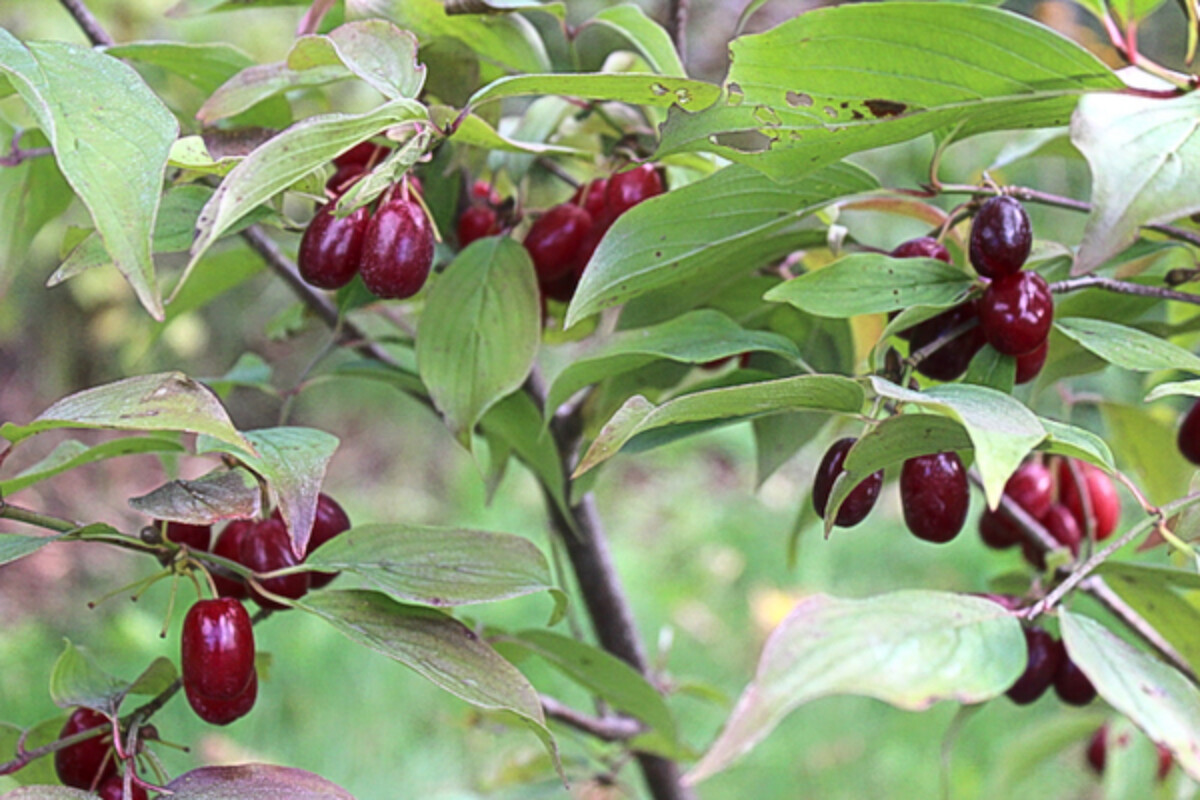
How to Grow Cornelian Cherry
The growth habit of cornelian cherry is somewhere between a bush and a small tree. They grow to somewhere between 15 and 25 feet tall, and large bushes can be 12 feet wide.
Since they’re a slow-growing plant, it can take decades for them to reach full size and they have an expected productive lifespan of about 150 years. If you’re planting cornelian cherry, make sure you pick a location that can handle their eventual size, even if you don’t live to see it.
Cornelian cherries aren’t picky about soil type, and though they prefer fertile well-drained soil, they can be grown on just about anything, including dense clay. That’s good news for our heavy clay soil.
The plants are hardy to either zone 4 or 5 depending on the cultivar. The plants flower very early in the spring, even earlier than forsythia. Given that, they may need protection from late frosts in colder areas like ours, we’ll see…
Harvesting Cornelian Cherry
Unripe cornelian cherries are tart and astringent, but the fully ripe fruit tastes like a cross between tart cherries and cranberries. The trick is, the fruit are not fully ripe until they fall from the bush. Even when they’re fully bright red, they’re not ready yet.
Truly ripe fruit is soft, and a deep red. The texture is a bit like a mushy plum that’s well past prime. At that stage, the fruit is soft and sweet-tart around a large oval-shaped seed.
The fruit are oval-shaped, with a large pit that’s firmly attached to the flesh. They’re tricky to pit, and generally, the fruit are boiled in a small bit of water until the fruit falls away from the pit.
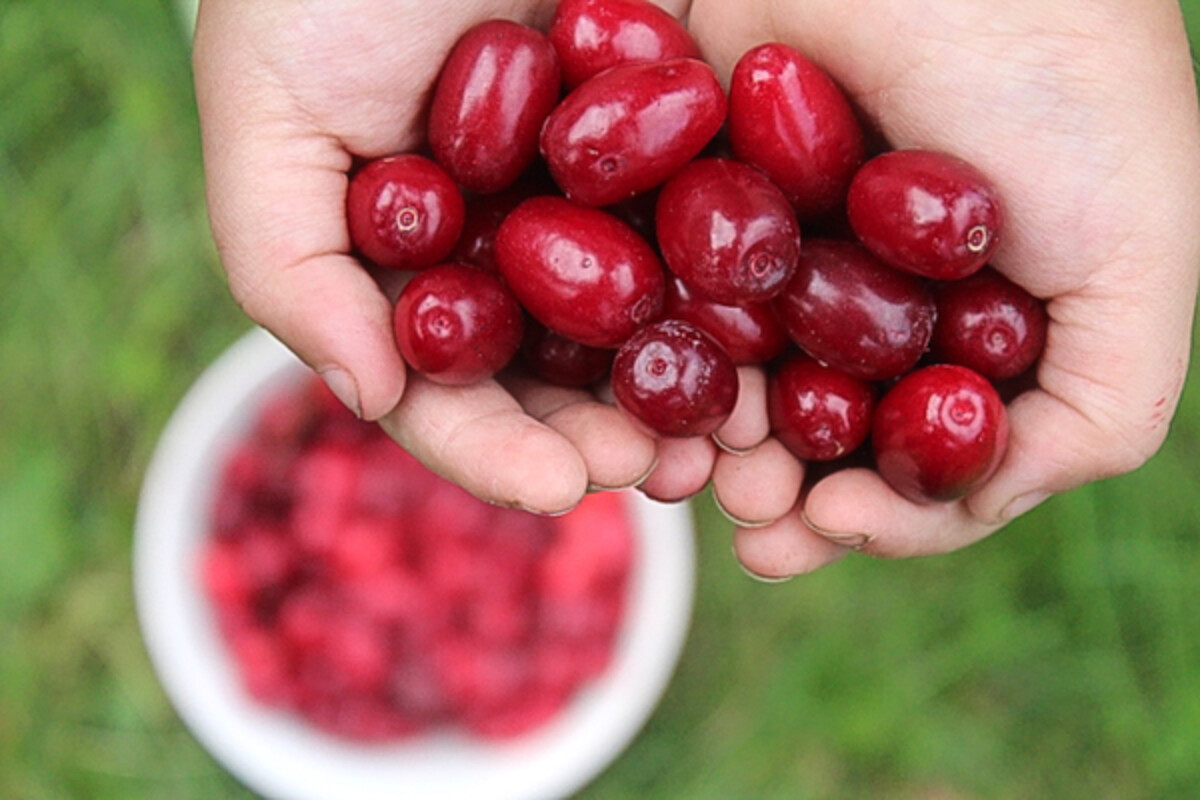
Propagating Cornelian Cherry
Since plants can be a bit hard to find, I fully intended to propagate the three varieties I now have on the homestead. I quickly learned that propagation, by cuttings or seed, is a bit tricky.
Growing Cornelian Cherry from Seed
Cornelian cherry seeds need very specific conditions for germination, and I’m not sure I can actually recreate them here in Vermont. Sources vary a bit, but most say that cornelian cherry seeds require somewhere between 90 and 120 days of warm moist stratification (above 68 degrees f).
After that, the seeds need an additional 90 to 120 days of cold stratification (below 39 degrees). That’s tough to accomplish, especially with fruit that ripens in early October.
Our growing season here in zone 4 is only 100 days long, and there are maybe 60 to 80 days that stay dependably above 68 degrees. It’s hard to keep it above 68 indoors, and often enough it’ll be below 50 in the morning when I wake up before the wood stove is loaded in the morning. Given these conditions, I’m not sure how to replicate them, indoors or out.
Propagating Cornelian Cherry from Cuttings
Given that seeds are tricky, the next logical choice is hardwood cuttings. Propagating grapes and many other plants is easiest by hardwood cuttings since moisture levels are less critical than with softwood cuttings. Cornelian cherries apparently don’t do well with hardwood cuttings, and most sources suggest taking greenwood cuttings in July or August.
That said, I ran across one study that had a 60% success rate with some cultivars, though others just wouldn’t root at all from hardwood cuttings. Since I have three varieties, I’ll try taking dormant cuttings late this winter and see how it goes. If that fails, then greenwood cuttings midsummer seem like the only choice.
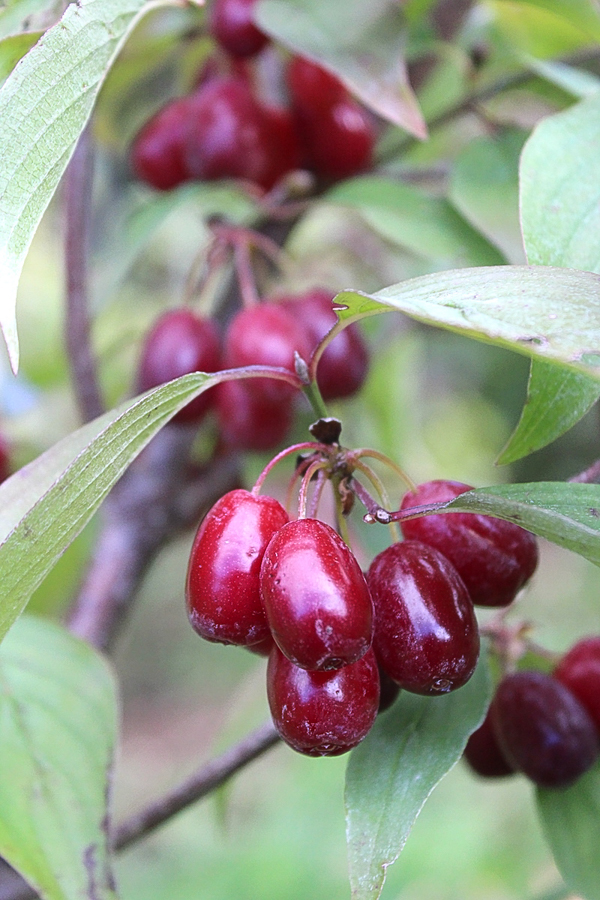
How to Use Cornelian Cherries
If the fruit are fully ripe, they’re sweet-tart with a very mild astringency. That’s too much for most American palates, but in the middle east, cornelian cherries are eaten as a snack with salt, and they’re also dried. The dried fruits are sold for use in traditional Chinese and Korean medicines for kidney issues.
Since the pits are so entrenched in the flesh, cornelian cherries are most commonly cooked into jams, jellies and syrups. With their rise in popularity in the US, they’re making their way into more westernized recipes from cheesecakes to fruit curds.
I made my own Cornelian Cherry Jam and my kids absolutely love it. If you want to try it, I also found the jam available for sale online.
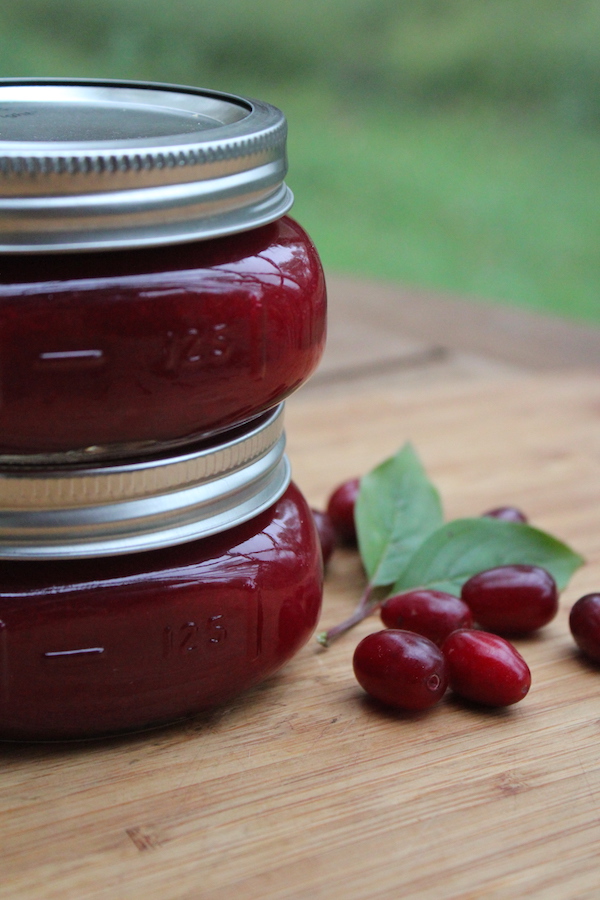
Though we lack ethnic markets here in rural Vermont, one of my readers was kind enough to share pictures of Cornelian Cherry juice that she purchased. These pictures come from Taryn of SharkGarden.org, and she describes the flavor:
“The flavor impression is acidic and starchy and medium sweet. I thought it tasted like cherries mixed with cooked rhubarb. Fairly refreshing, but the acidity became a bit much after half a glass.”
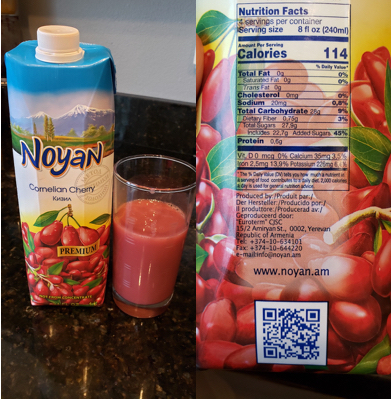
Cornelian Cherry Recipes
Since they’re still relatively uncommon, it’s tricky to find cornelian cherry recipes online, but I did track down a few:
- Cornelian Cherry Curd
- Cornelian Cherry Cheesecake
- Cornelian Cherry Juice
- Cornelian Cherry Liqueur (Krana)
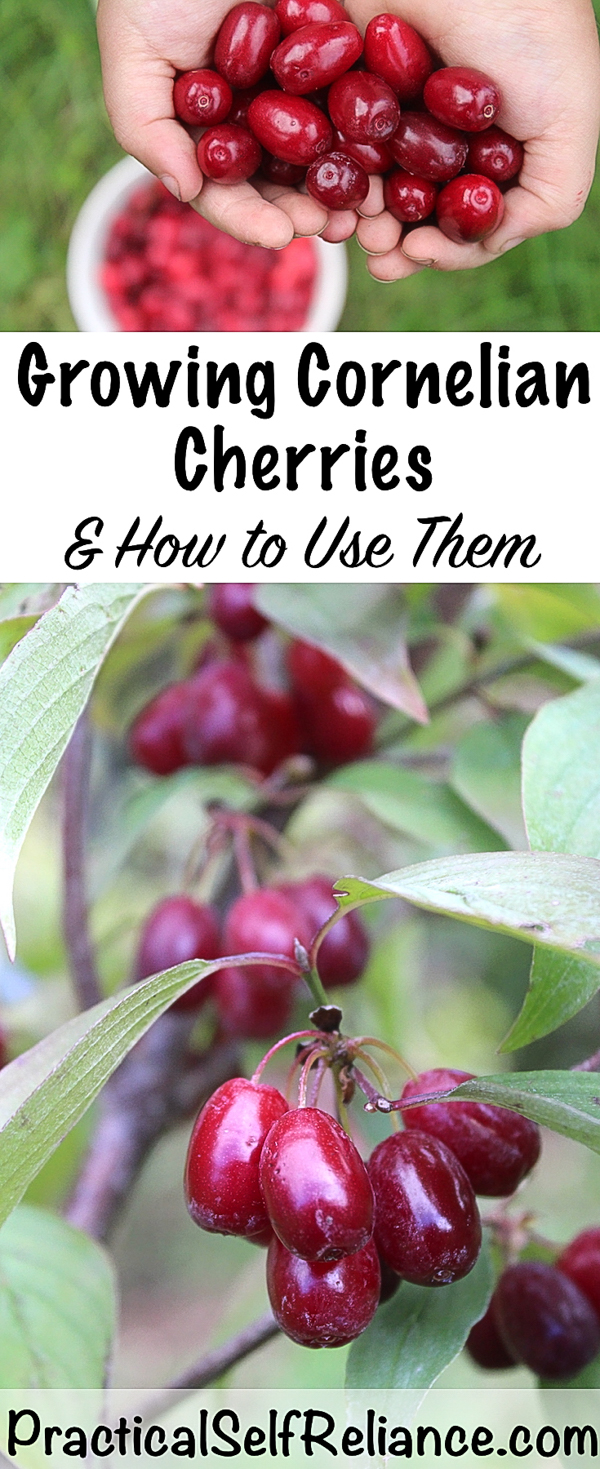
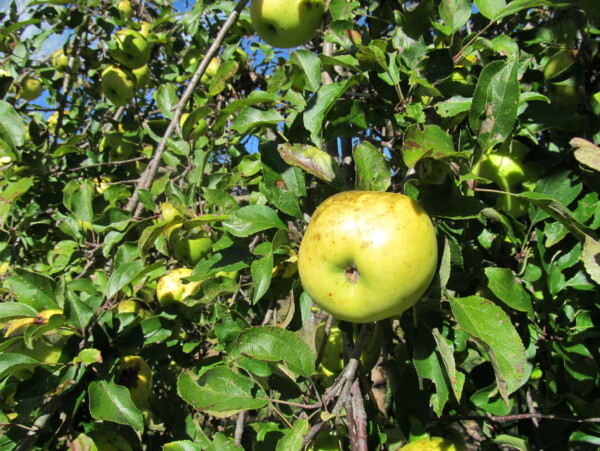













hello , could you sale cornelian cherry for me please
I don’t have any berries to sell unfortunately. You can sometimes find them on Foraged Market here: https://www.foraged.com/
Thank you dear Moderator for the comment. Same time every battery has its own limit to provide a power. If people don’t appreciate the result of my many years invested labor/money, why should I do that ?
Of course we gonna try to populate forces of nature and natural products as folk medicine. Same time a side assistance should be welcomed as well.
I hope you are on my side with Cornum mas growing.
It looks like Burnt Ridge Nursery doesn’t sell them anymore, but you can get them from fedco trees, which is where we get most of our plants these days. They’re sold out for this year, but if you get on their mailing list, you can order them next winter. They take orders for plants each winter and then ship them in March/April each year. https://fedcoseeds.com/trees/cornelian-cherries
You are right, mother nature provides us with endless opportunity to heal or support ouselbes naturally. For still undisclosed reasons American nation forgot about thoese recipes. Why ? I have no answer.
I tried to bring some articles copied from WebMed
I suspect it’s because most Americans like instant food and fruit (flavor) that is super sweet. People don’t want bitter or sour things. Because of the lack of nutrition, we are getting sicker and sicker as a society. It really bugs me when I go food shopping and see all of the pre-packaged food which is now creeping into the produce (fruits and vegetables) area. Lettuce is pre-chopped, as is squash, watermelon, you name it. Fruit salads are all pre-made and ready to serve. (And of course, cost triple the amount of the original. How hard is it to do these things? Not at all. We are losing the ability to prepare, cook and appreciate whole foods. The packaging and amount of plastic required is another whole discussion!
I did want to point out that sour cherry and Cornelian cherry are two different types of plants. You talk about sour cherry and name the varieties, which are, indeed, sour cherries, but sour cherries are not Cornelian cherries, even though they may be used in similar ways.
Yo are very right Barb about pre-packed food ready for consumption. American society encourages workaholism. Comparing to Europe where “overtime” is a very-very rare business mode, Americans use to make double salary just on overtime.
Of course, our moms/wives have no time to prepare food as it was in a year 1960. I see nowadays working Americans use their stomach as a chimney chamber and pre-cooked food as a coal.
Look at Europe – 4 working days week. I think our society requires a big and painful re-design, reload, values re-estimation. You cannot earn all money.
I’m sorry for the confusion my reply could create about Cornelian Cherry. That is why I like to name it Cornus Mas ( in Latin). Definitely sour cherry and Cornelian cherry are two different trees, I know that. I was talking about sour cherry varieties that here in the USA commonly calls as pie cherry.
Based on my small farmer’s experience, American people aka customers are extremely conservative if don’t use sounds offensive word ignorant. Have no idea how many years or generations have to pass through their mind to accept something new to consume as folk medicine, preventive medicine
I grew Conus mas on my small farm around Binghamton, NY and brought fruits to Farmers market. I got nothing in return( no sale) except several customers asking questions about what those berries are. I’m talking about NYC customers. Exactly the same story/experience I have with with Schizandra Chinensis and Sea Buckthorn berries.
American people know only several varieties of edible berries : blueberry, strawberry and sometime they are familiar with gooseberry. Not many know what black or red currant is, how to use /consume it following a prevention medicine protocols.. So pity American Big Pharma brainwashed the nation same time seeded an illusion all diseases could be fixed overnight with synthetic pills.
Should be great to popularize mother nature remedies people can grow themselves. How to do that ?
I think you make some good points there. I think the best thing to do is to keep sharing information and sharing our knowledge as often as we can.
Hi Bogdan,
I live in Toronto Ontario, Canada and here no one knows about Cornelian Cherries!
As a Serbian we are very familiar with this fruit and their enormous health benefits.
In Serbian language when we want to say that someone is a very healthy person, we say; he/she is ‘Healthy as Cornelian’! It is known since ancient times!
Please do you have some dried ones for sale? Or when they are ripened?
Would love to hear from you.
Thank you
My warmest regards
Milica
I Have dried fruit for sale.
I am in Ontario, Canada.
You can email me at kamsharifi70@gmail.com
Thank you Milica for the comment. Indeed, I found descendants from Easter Europe are more educated or let me say informed about folk medicine comparing to Americans or Canadians. It is very rare to meet an American who knows what bee propolis is and even more rare to talk to a person who knows how to use propolis for health support.
Cornelian Cherry in English or Kizil in Russian were a natural source of many vitamins for Ukrainians for centuries. Modern Americans and I think Canadians go to a pharmacy to buy Vitamin C , B, E, A …… not to the garden. Nowadays generation forgot what a human digestive system is and how all vitamins suppose to be absorbed and delivered to us.
I grow not only Cornus Mas ( Cornelian Cherry) on my land but Sea buckthorn berry, red and black currant, blueberry and blackberry, strawberry and zemliyanika , I try to get Ukrainian sour cherry ( real one) but our Custom forbids me to import such trees to the USA. We drink now only chaga and reishi teas that I do collect from my own forest. we stopped buying meat or chicken, we shifted on venison that I got on my property during hunting season. I do consume beaver castoreum if you know what is that. Same time we live in New York City, eating own quince, apples, pears, potatoes, garlic. Funny, right ?
We grow all of those here too. Or at least all but Ukrainian sour cherry. We grow 5 varieties of sour cherry here, but there’s no way to know if they’re anything like the ones you’re talking about. All quite good though!
Nice to know you have 5 varieties of a sour cherry. Tell me please their names. So far I am familiar with Montmorency and North Star. They look good but the major problem ( my problem) is the juice from those fruits are see through, not like a vein blood, a color Ukrainian varieties produce.
You can tell me secretly if you (somehow) received seedlings or scions from Ukraine directly. I would identify the variety if you gonna show me the fruits and its juice.
I tried to import them legally but it seems merely impossible on my end to satisfy FDA requirements. I have to be a huge nursery business owner to afford the procedure. Even One Green World cannot do this while they have dozens of Ukrainian and Russian selection varieties. They keep in secret the source of scions or propagation materials.
I wish I could get someone from Ukraine to send me seeds directly, but no luck. I did get a friend that gave me seeds from her flowering quince from Latvia (Chaenomeles sp.) that she brought back in her suitcase long ago when restrictions were a bit more lax. The fruit is good, and I have seeds from that one that I gave away on my newsletter (I have a few more I can send you if you’d like). But no sour cherry, unfortunately.
Yes, the juice is clear when you press it from the ones in the US. If you extract it with a steam juicer, it looks more red, and you can see that in my posts on cherry jelly (https://creativecanning.com/cherry-jelly/) and cherry wine (https://practicalselfreliance.com/cherry-wine/).
For varieties, we have English Morello, Mesabi, Meteor, Montmorency and another that the local nursery labeled “sweet pie cherry” the local nursery said was sweeter than the others (but it’s pretty similar).
Fedco has a pretty nice selection: https://fedcoseeds.com/trees/pie-cherries
Thank you so much for this great article! When I was a child in the ’70’s, in Ontario, Canada, my mother had a Cornelian cherry tree that was her pride and joy. It grew prettily in a corner of our backyard and I remember going to check on the cherries daily, waiting for the moment they became delicious instead of mouth-puckering. My mother is long gone, (rest her gentle soul), but your article has inspired me to try to find and grow a Cornelian cherry in my new home in Nova Scotia. I’m very slowly converting my lawn to ‘food forest’ and I’m finding your articles very, very informative and useful. Thanks for all the clear information!
You’re so welcome. That is such a touching story.
I have a very caprice soil on my farm ( Ph4.4) and not much what tolerates such acidity but pin cherry grow like crazy. I have no much stamina to remove them manually. I want to know if I can graft Cornelian cherry on such root stock. Maybe you have an experience , maybe somebody else know if such two cherries are DNA weldable.
I don’t have any personal experience with this. I did a quick search and the only thing I was able to find was the same question on growingfruit.org which looks like was your question there.
I got an experience now. It does not work. My grafting failed on 5 out of 5 attempts.
Don’t know why. Same time I got a very good rooting cuttings ratio. I just inserted them into the soil and forgot for a summer time. 80% got me roots.
well, I collected cutting from a city park tree with not big fruits variety, so I’m gonna use them this year as a grafting base ( seedlings).
Good to know!
Maybe try a local college botanist or extension office; they could probably work on getting you an answer. Good luck. If you find the answer, let us know!
Barb, you gonna be surprised how dumb and initiative less people are nowadays. They are curious free. I contacted those all variable options Cornell Univ. Extension, local gardeners and nursery owners. 95% of them never heard about Cornelian cherry. moreover nobody tried to graft pin cherry with anything else.
This year, having suffice American variety sour cherry scions, I’m gonna try to graft pin cherries with sour cherry.
Last year all my grafted pin cherries produced side branches lowed grafting point and no one graft has survived.
There is red and yellow tree on Bainbridge Ave and Mosholu Prkwy in the Bronx. Not tasty at all. Sour and tart.
I ordered a few this past year and they will be arriving come spring. I’m in my sixties, so there might not be a lot of time to futz around with seeds that may never develop! The plants weren’t cheap, but either are the years wasted in trying to get something to grow that may never sprout! If I were in my 30’s, I might feel differently! The ones I ordered remain relatively small (6′), but supposedly are very flavorful. I’m excited for the spring flowering as much as for the fruit. I will have three cherry trees and 12 bush cherries, along with 50+ other kinds of fruits, but flowers in early spring after a long Vermont winter, are priceless!
Ashley, you mentioned getting yours at a plant auction. Is this an annual event, and if so, where is it? I would love to get some mature plants like you were able. I’m willing to drive a fair distance for such a thing. Barb
The plant auction was at EC browns in Thetford, but the original owner died, and they stopped doing them when his kids too over. Too bad, but I think they did them in the first place because the old guy loved being an auctioneer. There are no other plant auctions in VT that are currently running since 2020, at least that I’m aware of. If you hear about any, let me know! They were the perfect place to get the obscure stuff for cheap, no one knew what it was, so it was always a steal!
Thank you for the great article Ashley. I just wanted to mention that here in zone 5 Maine I’m seeing seedlings growing under my ‘Yellow’ cornelian cherry that I bought from One Green World. Can’t wait to move them to their permanent home and see what results!
That’s super exciting.
Your description of germination requirements and seeing these under my tree makes me wonder if they might have to go through two winters up here (double dormancy). I’ll try and be more observant.
We have pawpaws that we’re planted eleven years ago and are just now getting fruit. It was worth the wait. They were little stick trees when they went in, and the female is large and lovely. The male is still kind of dinky, but as long as the pollination happens we’re happy. Northern Willamette valley, Oregon.
Pawpaws are definitely worth the wait. Thanks for sharing!
Such long waiting period of time is what I expected from a seedling. Nevertheless, a well known papaw’s propagator from PA stated his seedlings start fruiting on 8th year. We start a discussion regarding what version : grafted or seedling is gonna give us fruits faster. He stated does not matter base don his 22 years of experience dealing with papaws.
Some people have 11 years to wait, some, unfortunately, don’t
That is why, I think, to provide with realistic information to prospective gardeners about pawpaw fruiting age is important.
Hi.
Do you or anyone know where I can buy the actual fruit?
Thanks.
Simon
I don’t. Sorry! Have you checked your local farmer’s market?
I have a beautiful mature Cornelian Cherry and in most springs I end up with several plants growing under the tree. I am not sure if they are Cornelians or something else and they are removed every year as beds are cleaned. Anyone have an image of a one or two year old plant?
Take a look at the leaves once they leaf in all the way. They also may be just suckers off the parent plant maybe?
great article, there’s not a lot of information out there on cornelian cherry.
However, we purchased a lot of trees to create a hedge out of them. It’s around 35 plants and they where grown in the Netherlands and pruned mechanically. They were 10 yrs old then and I’ve had them since 2014.
Recently I came up with the idea of see if a seed would germinate. I’ve had it stored in a pot at around 29 degrees celsius for three weeks with basically nothing happening so I went online to check if there was any info on that.
Haha , wow I wasn’t aware how hard they are to grow from seeds. But I’ll keep trying with the seeds I have. So basically in roughly 2 months i’ll put them in the fridge at around 6 degrees celsius for another 2-3 months.
Also when tasting the fruit ealier this summer i stuck two seeds down in the yard and that was two months ago , since winter is coming maybe by next year in spring there will something there, who knows. I did it most to play around.
For sure I’ll try and use branches next year, seems the easiest when you have the trees around.
Ill link to some pictures taken today of the hedge outside my house.
https://i.ibb.co/KFqZzwP/IMG-4617.jpg
https://i.ibb.co/RQbTf1y/IMG-4618.jpg
https://i.ibb.co/f2Zk4b6/IMG-4624.jpg
https://i.ibb.co/H7m80MW/IMG-4625.jpg
Just an update on my overwintered cherry seeds in the ground – they didn’t grow. Neither did the winter-sown Elaeagnus seeds in the milk jug. The chipmunks seem to have dug up and eaten all the cherry seeds (GRRR!!!). My brother gave me some that he had overwintered dry in a plastic bag in his basement workshop. I planted them this spring and am keeping them moist, but no signs of life from them, either.
Now I’m trying “the difficult, if not impossible,” growing pawpaw (Asimina triloba) root suckers I dug in early June. After getting as much of the lateral roots with each vertical sucker as I could, I planted them in two tubs of potting mix, inside my greenhouse, watered and misted them heavily, and put clear plastic trash bags over them. Every few hours I would mist them again, to keep the leaves from drying out. I kept the bags over the tubs for a couple of weeks, then removed them and continued misting every 2-4 hours all day (when I was home). Gradually I reduced the misting when they didn’t look wilted between misting, and now I just do it early morning and late evening, only during the day if it’s really hot and they droop a little. I dug two yesterday to pot for a friend, and was very pleased to see they were growing nice little feeder roots in various places on the lateral root. Pawpaws grow enormous taproots very quickly after germination, but they’re kind of finicky about germinating – the seeds must NEVER dry out, but be planted fresh, or taken from the fruit, cleaned and put immediately in a bag of moist potting soil and stratified in a refrigerator for 90-120 days. If they dry out, it can reduce the germination rate by as much as 80% or more. (They won’t grow!) That explains why the four seeds I planted last fall didn’t grow – they were dry. I would not buy pawpaw seeds online for that reason! Either buy seedlings or grafted trees.
Woah, good to know! I wish pawpaw would grow here, there are a few experimental cultivars showing some hardiness in our climate at a local nursery, but no fruit yet. Maybe someday! But I didn’t know that about their germination…now if I do find cultivars I’ll definitely skip seeds. Good luck with your cornelian cherries, I hope it works out if you try again.
I will definitely be trying again – I’m stubborn, if nothing else!
Several online retailers sell already stratified and/or current season pawpaw seeds.
Englands Orchard and Nursery
Nash Nursery
Red Fern Farm
Peaceful Heritage Nursery
I will experiment planting Cornelius mas seeds I picked today.( At least I know I like the taste)
I was planning to try half of them in the drupe to ensure moisture what do you think about this? I could keep them under the coal door for now then in the fridge. In the winter it would be too cold under the coal door here in Pittsburgh.
I’ve not yet tried growing them from seed, so I don’t have any personal advice, unfortunately. In one of the comments above there’s a link to detailed instructions for growing from seed that I found really helpful. Good luck!
In the event someone is interested in technical information: https://plants.usda.gov/plantguide/pdf/pg_cofl2.pdf
“Flowering dogwood seeds can be hand-sown into outdoor beds soon after collection (September to October). This allows for the seeds to undergo natural warm stratification prior to exposure to cooler winter temperatures. Imbibe seeds overnight, dust with fungicide, and hand-sow 5 to 6 inches apart in rows. Sprinkle endomycorrhizae over the seed before covering with soil. Mulch the bed with sawdust. Seeds can be artificially cold stratified for 100 to 130 days and germinated at 15 to 27oC. Prior to spring emergence (March to April), remove mulch. Place shade cloth above newly emerged seedlings and keep it in place until August. Flowering dogwood can also be propagated by cutting, grafting, layering, and root division. It roots easily from cuttings taken in June or immediately after the plants bloom. Cut 8 cm of the terminal shoot tip, keeping 2 to 4 leaves, and dip into a one part indole-butyric acid (IBA) to 250 part talc (by weight) mixture. Set cuttings approximately 3 cm deep in rooting medium and grow under a misting system with a photoperiod of at least 18 hours.”
Thank you so much! This is really helpful =)
Hi,
How old were your cornelian cherries ries before they fruited? Were they grafted?
If a seedling was the taste acceptable for a chance seedling plant?
Thank you, Kamyar
Since ours were already mature when we got them, I don’t know personally how long it takes for them to begin bearing fruit. I did a bit of research for you and I found a few other sites saying 4-5 years old before they’d begin bearing fruit. I’ve seen places selling seedlings, but I don’t know about the fruit quality personally, ours were grafted named varieties.
I ordered two Cornelian Cherry bushes in the spring – 2017 – they were ten inches tall. This is the first year they had fruit (2022). In early March there was a flush of small yellow flowers. I gave the bushes rabbit droppings for fertilizer twice during spring and during hot, dry spells they get watered. They are six feet tall now. FYI we live in southern Indiana, planting zone 5a.
In mid July, there are red cherries on the bushes. I wait until they fall off and pick them up each morning. The cherries from one bush are sour and the other one is a little sweet.
It will be a while! I planted two last year, and I know that I will have to wait a number of years. I took out an out-of-control forsythia that was becoming a beast and tip rooting everywhere it could. The Cornelian cherries are in its stead. They should be well-behaved and offer so much more: I’ve read that they bloom even earlier than forsythia and the fruit will be beautiful even if it turns out that I don’t like the taste…although there is very little that I don’t eat, so I’m sure I’ll like them.
I collected a handful of Cornelian cherry fruits under a tree growing in Ithaca, NY, late last fall, and planted them about an inch deep in my propagation bed in back of my house. I put a piece of hardware cloth (wire mesh) over it to keep birds from digging them up, and am now awaiting spring to HOPEFULLY see them sprout!
I’m also attempting a winter-sowing of silverberries (Elaeagnus umbellata) in a milk-jug with seed-starting mix, moistened, and set out in the propagation area. The berries had dried before planting, so I don’t know if they’ll grow. I have more in the freezer, if these don’t, and a seedling bush that came up voluntarily in a flower-bed that I will take cuttings from to root – I need to be taking a LOT of cuttings from various things!
Have you tried soaking your cuttings in willow-water before sticking them in soil? ALL species of willow (Salix) naturally produces the indolebutyric acid (IBA) used in the rooting-hormone you buy, so if you’re truly “off-grid,” make your own IBA! Snip 2-3 foot pieces of willow-branch tips, cut them in 1-3″ pieces, and soak them 24-48 hours in lukewarm water, or overnight in hot water. It keeps in storage for 2 months or more, and you just soak your cuttings in some for a few hours before sticking them. You can also stick the cuttings, then water them in the propagation bed/box/or whatever you’re growing them in, twice, soaking the soil each time. After that, use regular water.
Thanks for the informative article! I’ve been wanting these for years and I think I’m going to buy seed this year (I’d kind of like the diverse genetics, plus it’s cheaper), so I’m just doing a bit of research.
The reason I’m commenting though–since you’re off-grid, a seedling heating mat is probably out of the question, but what about using thermal mass around the seeds you’re trying to warm-stratify? Like stack some warm bricks around the pots at night, or even a gallon jug or pot of hot water next to the stratifying seeds, then draped with a blanket or covered with a cardboard box to make a little heat tent? It might not be 68 the whole time, but it would keep it a few degrees warmer, which might just be enough.
Anyway, good luck with your propagating 😀
I recently found a supplier of cornelian cherry seedlings, and they’re MUCH cheaper than just about anywhere else. It’s a wholesale nursery, and bulk things like hazelnuts are as little as $1-2 per plant. Small, but designed for local nurseries to buy and then grow out themselves and sell for a 10-20x markup. They have cornelian cherries here: https://www.burntridgenursery.com/CORNELIAN-CHERRY-DOGWOOD-Cornus-mas/productinfo/NSDOCOR/
If for whatever reason your seedlings don’t pan out, that’s a good backup plan. Either way, please let me know hot it goes with your seedlings, I’d love to hear about your process.
I proceeded to the link you provided but the company have no Cornelian cherry at all. Are you sure the website address is correct?
That is the correct link but I’m not seeing them now either. Maybe contact them directly and ask them.
I got my Cornelian cherries from Cricket Hill. I’ve seen them offered elsewhere, like Hidden Springs nursery.
Based on my 2024 year experience, I was successful with air layering method. I got roots on 100% of stroots . I found the tree on NYC public land and performed air layering technique without a problem. Recommend.